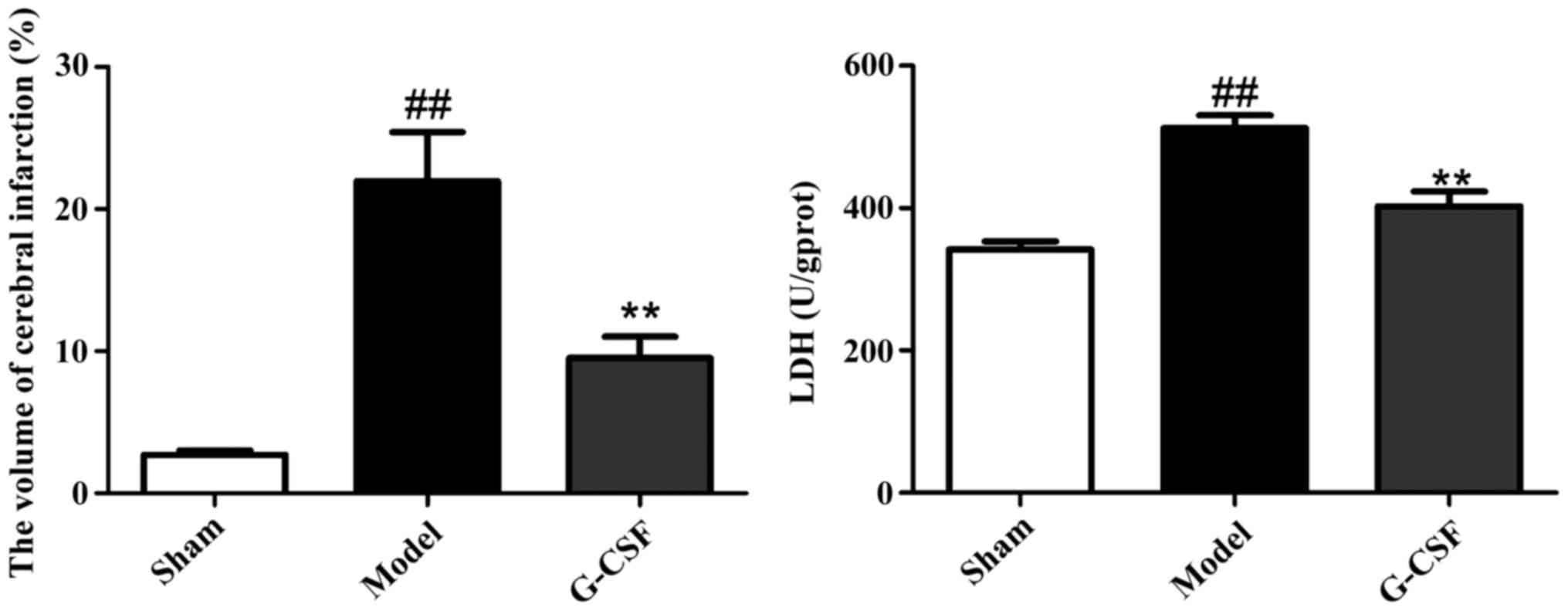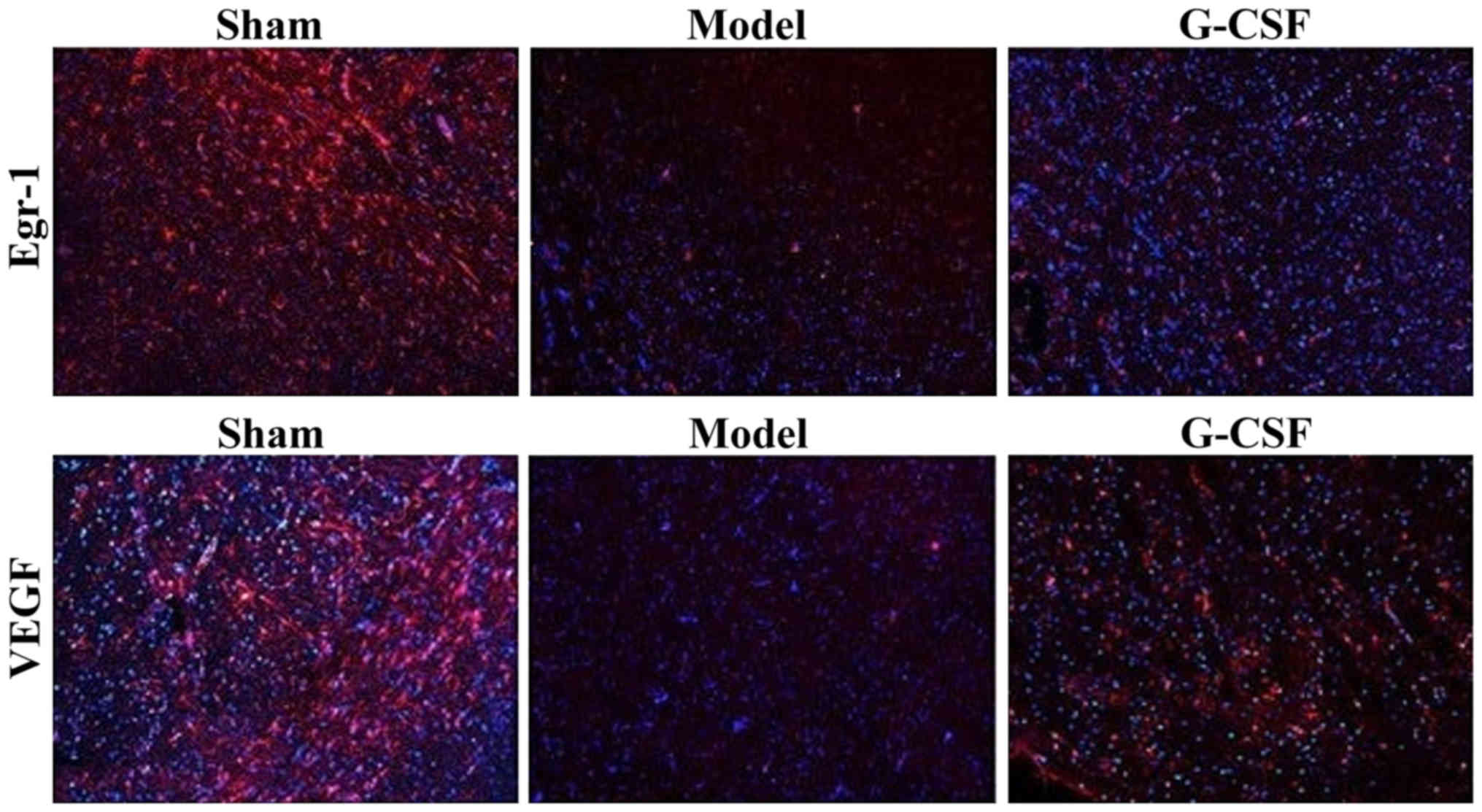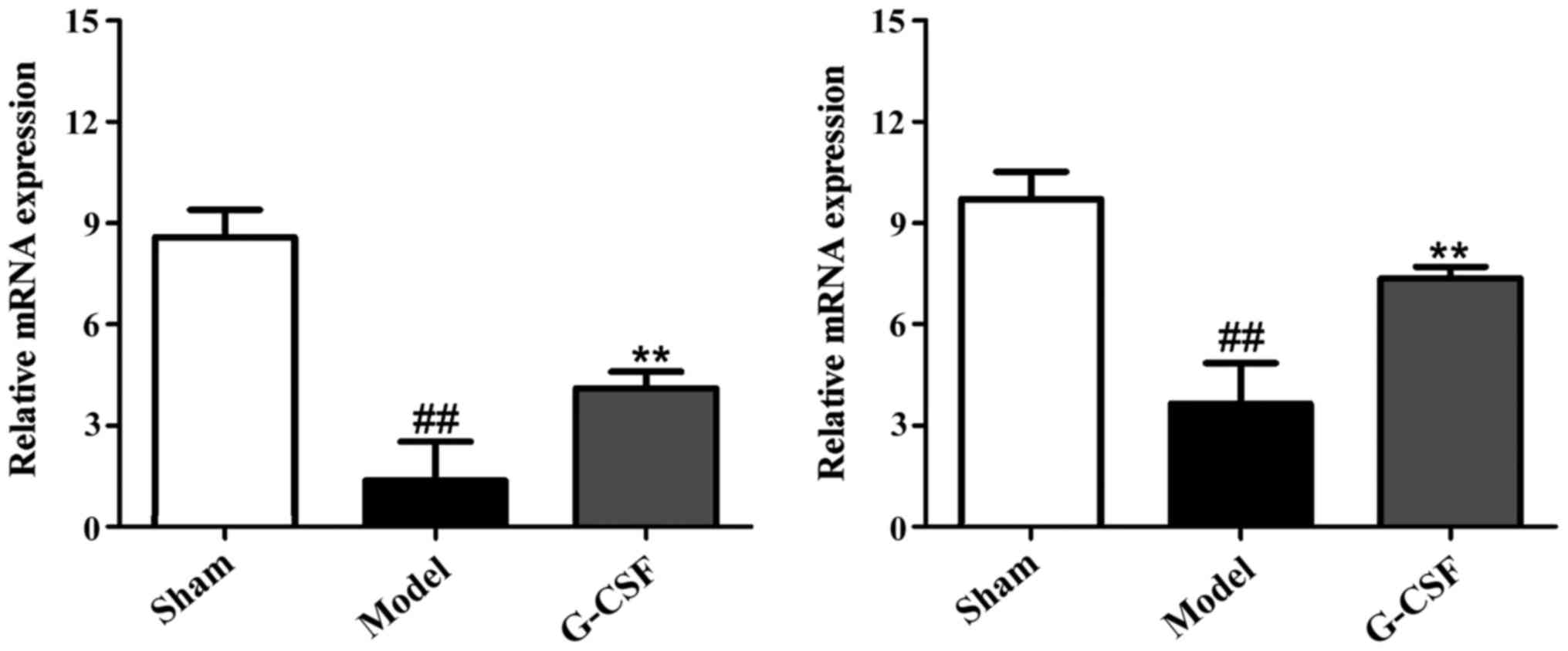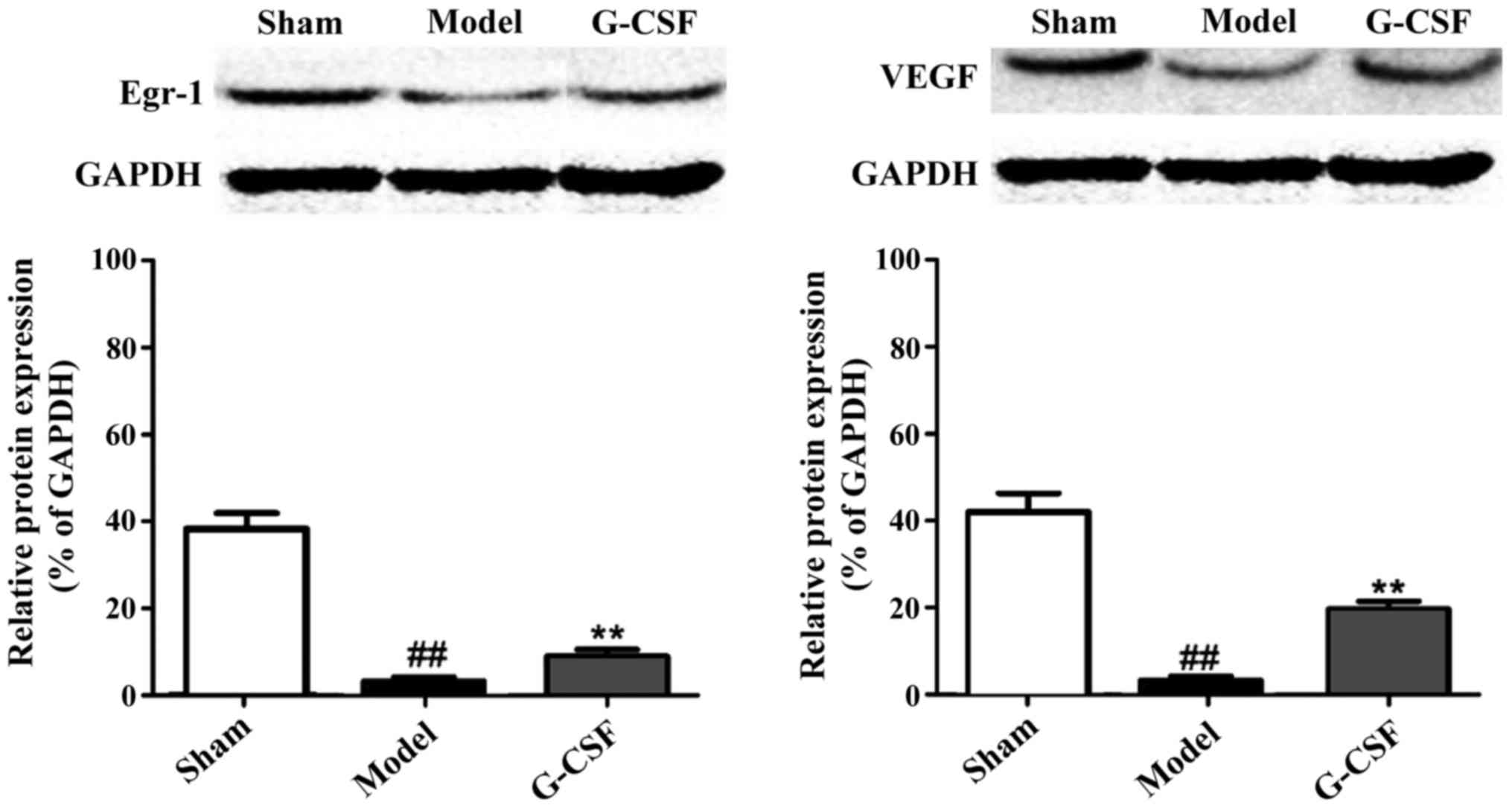|
1
|
Du H, Naqvi H and Taylor HS:
Ischemia/reperfusion injury promotes and granulocyte-colony
stimulating factor inhibits migration of bone marrow-derived stem
cells to endometrium. Stem Cells Dev. 21:3324–3331. 2012.
View Article : Google Scholar : PubMed/NCBI
|
|
2
|
Fan L, Chen L, Chen X and Fu F: A
meta-analysis of stem cell mobilization by granulocyte
colony-stimulating factor in the treatment of acute myocardial
infarction. Cardiovasc Drugs Ther. 22:45–54. 2008. View Article : Google Scholar : PubMed/NCBI
|
|
3
|
Dai W, Hale SL, Martin BJ, Kuang JQ, Dow
JS, Wold LE and Kloner RA: Allogeneic mesenchymal stem cell
transplantation in postinfarcted rat myocardium: Short- and
long-term effects. Circulation. 112:214–223. 2005. View Article : Google Scholar : PubMed/NCBI
|
|
4
|
Fuchs S, Baffour R, Zhou YF, Shou M,
Pierre A, Tio FO, Weissman NJ, Leon MB, Epstein SE and Kornowski R:
Transendocardial delivery of autologous bone marrow enhances
collateral perfusion and regional function in pigs with chronic
experimental myocardial ischemia. J Am Coll Cardiol. 37:1726–1732.
2001. View Article : Google Scholar : PubMed/NCBI
|
|
5
|
Schneider A, Krüger C, Steigleder T, Weber
D, Pitzer C, Laage R, Aronowski J, Maurer MH, Gassler N, Mier W, et
al: The hematopoietic factor G-CSF is a neuronal ligand that
counteracts programmed cell death and drives neurogenesis. J Clin
Invest. 115:2083–2098. 2005. View
Article : Google Scholar : PubMed/NCBI
|
|
6
|
Schäbitz WR, Kollmar R, Schwaninger M,
Juettler E, Bardutzky J, Schölzke MN, Sommer C and Schwab S:
Neuroprotective effect of granulocyte colony-stimulating factor
after focal cerebral ischemia. Stroke. 34:745–751. 2003. View Article : Google Scholar : PubMed/NCBI
|
|
7
|
Kawamoto A, Gwon HC, Iwaguro H, Yamaguchi
JI, Uchida S, Masuda H, Silver M, Ma H, Kearney M, Isner JM, et al:
Therapeutic potential of ex vivo expanded endothelial progenitor
cells for myocardial ischemia. Circulation. 103:634–637. 2001.
View Article : Google Scholar : PubMed/NCBI
|
|
8
|
Murry CE, Soonpaa MH, Reinecke H, Nakajima
H, Nakajima HO, Rubart M, Pasumarthi KBS, Virag JI, Bartelmez SH,
Poppa V, et al: Haematopoietic stem cells do not transdifferentiate
into cardiac myocytes in myocardial infarcts. Nature. 428:664–668.
2004. View Article : Google Scholar : PubMed/NCBI
|
|
9
|
Olivetti G, Capasso JM, Meggs LG,
Sonnenblick EH and Anversa P: Cellular basis of chronic ventricular
remodeling after myocardial infarction in rats. Circ Res.
68:856–869. 1991. View Article : Google Scholar : PubMed/NCBI
|
|
10
|
Park KI, Hack MA, Ourednik J, Yandava B,
Flax JD, Stieg PE, Gullans S, Jensen FE, Sidman RL, Ourednik V, et
al: Acute injury directs the migration, proliferation, and
differentiation of solid organ stem cells: Evidence from the effect
of hypoxia-ischemia in the CNS on clonal ‘reporter’ neural stem
cells. Exp Neurol. 199:156–178. 2006. View Article : Google Scholar : PubMed/NCBI
|
|
11
|
Pastuszko P1, Liu H, Mendoza-Paredes A,
Schultz SE, Markowitz SD, Greeley WJ, Wilson DF and Pastuszko A:
Regulatory pathways to neuronal injury or survival are dependent on
the rate of low flow cardiopulmonary bypass following circulatory
arrest in newborn piglets. Eur J Cardiothorac Surg. 31:899–905.
2007. View Article : Google Scholar : PubMed/NCBI
|
|
12
|
Rosenstrauch D, Poglajen G, Zidar N and
Gregoric ID: Stem celltherapy for ischemic heart failure. Tex Heart
Inst J. 32:339–347. 2005.PubMed/NCBI
|
|
13
|
Tang YL, Zhao Q, Qin X, Shen L, Cheng L,
Ge J and Phillips MI: Paracrine action enhances the effects of
autologous mesenchymal stem cell transplantation on vascular
regeneration in rat model of myocardial infarction. Ann Thorac
Surg. 80:229–236, discussion 236–237. 2005. View Article : Google Scholar : PubMed/NCBI
|
|
14
|
Xiao BG, Lu CZ and Link H: Cell biology
and clinical promise of G-CSF: Immunomodulation and
neuroprotection. J Cell Mol Med. 11:1272–1290. 2007. View Article : Google Scholar : PubMed/NCBI
|
|
15
|
Pastuszko P, Schears GJ, Pirzadeh A,
Greeley WJ, Wilson DF and Pastuszko A: Effect of granulocyte colony
stimulating factor (G-CSF) on expression of select proteins
involved in apoptosis in a neonatal piglet brain following
cardiopulmonary bypass (CPB) and deep hypothermic circulatory
arrest (DHCA). J Thorac Cardiovasc Surg. 143:1436–1442. 2012.
View Article : Google Scholar : PubMed/NCBI
|
|
16
|
Gibson CL, Bath PM and Murphy SP: G-CSF
reduces infarct volume and improves functional outcome after
transient focal cerebral ischemia in mice. J Cereb Blood Flow
Metab. 25:431–439. 2005. View Article : Google Scholar : PubMed/NCBI
|
|
17
|
Lee ST, Chu K, Jung KH, Ko SY, Kim EH,
Sinn DI, Lee YS, Lo EH, Kim M and Roh JK: Granulocyte
colony-stimulating factor enhances angiogenesis after focal
cerebral ischemia. Brain Res. 1058:120–128. 2005. View Article : Google Scholar : PubMed/NCBI
|
|
18
|
Tang YL, Zhao Q, Zhang YC, Cheng L, Liu M,
Shi J, Yang YZ, Pan C, Ge J and Phillips MI: Autologous mesenchymal
stem cell transplantation induce VEGF and neovascularization in
ischemic myocardium. Regul Pept. 117:3–10. 2004. View Article : Google Scholar : PubMed/NCBI
|
|
19
|
Cheng Z, Liu X, Ou L, Zhou X, Liu Y, Jia
X, Zhang J, Li Y and Kong D: Mobilization of mesenchymal stem cells
by granulocyte colony-stimulating factor in rats with acute
myocardial infarction. Cardiovasc Drugs Ther. 22:363–371. 2008.
View Article : Google Scholar : PubMed/NCBI
|
|
20
|
Su H, Lu R and Kan YW: Adeno-associated
viral vector-mediated vascular endothelial growth factor gene
transfer induces neovascular formation in ischemic heart. Proc Natl
Acad Sci USA. 97:13801–13806. 2000. View Article : Google Scholar : PubMed/NCBI
|



















